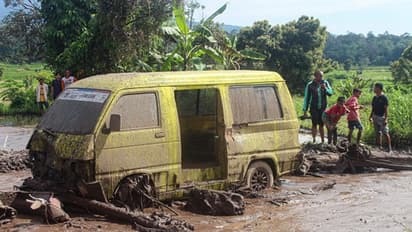Mount Marapi flash floods: Heavy rains, cold lava claim dozens of lives in Indonesia; WATCH viral videos

Synopsis
Flash floods caused by heavy rains and torrents of cold lava and mud cascading down the slopes of Mount Marapi on Indonesia's Sumatra island have resulted in the tragic loss of at least 37 lives.
Flash floods caused by heavy rains and torrents of cold lava and mud cascading down the slopes of Mount Marapi on Indonesia's Sumatra island have resulted in the tragic loss of at least 37 lives, with over a dozen individuals still unaccounted for, according to officials on Sunday.
The combination of monsoon rains and a significant mudslide triggered by the cold lava flow led to the breach of a river, which subsequently surged through mountainous villages across four districts in West Sumatra province, occurring just before midnight on Saturday. The devastating floods swept away people, submerged more than 100 homes and structures, as reported by National Disaster Management Agency spokesperson Abdul Muhari.
By Sunday afternoon, rescue teams had recovered 19 bodies from the hardest-hit village of Canduang in Agam district, with an additional nine bodies retrieved in the neighboring Tanah Datar district, as stated by the National Search and Rescue Agency.
The agency reported that eight bodies were extricated from the mud in the wake of the deadly flash floods that also affected Padang Pariaman, while another casualty was discovered in Padang Panjang city. Currently, rescuers are actively searching for 18 individuals who are reported missing.
Flash floods on Saturday night also led to the main roads surrounding the Anai Valley Waterfall area in Tanah Datar district being obstructed by mud, thereby severing access to other cities, according to Padang Panjang Police Chief Kartyana Putra on Sunday.
Videos circulating on social media platforms depicted roads transformed into murky brown rivers, illustrating the extent of the devastation caused by the flash floods.
This disaster occurred merely two months after heavy rains triggered flash floods and a landslide in West Sumatra’s Pesisir Selatan and Padang Pariaman districts, resulting in the loss of at least 21 lives and leaving five individuals unaccounted for.
Standing at 2,885 meters (9,465 feet), Mount Marapi experienced an eruption late last year that claimed the lives of 23 climbers who were caught off guard by a sudden weekend eruption. Since 2011, the volcano has remained at the third highest alert level out of four, indicating elevated volcanic activity. As a precautionary measure, climbers and villagers are required to maintain a distance of more than 3 kilometers (about 2 miles) from the peak, as advised by Indonesia’s Center for Volcanology and Geological Disaster Mitigation.
Marapi is renowned for its unpredictable eruptions, characterized by shallow sources near the peak, which are not typically preceded by deep movements of magma that generate seismic tremors detectable on monitors.
Despite its recent eruption in January 2023, which fortunately resulted in no casualties, Mount Marapi has maintained its activity, adding to Indonesia's list of over 120 active volcanoes. Given its location along the Pacific “Ring of Fire,” Indonesia remains susceptible to seismic activity due to the presence of volcanoes and fault lines encircling the Pacific Basin.
Check the Breaking News Today and Latest News from across India and around the world. Stay updated with the latest World News and global developments from politics to economy and current affairs. Get in-depth coverage of China News, Europe News, Pakistan News, and South Asia News, along with top headlines from the UK and US. Follow expert analysis, international trends, and breaking updates from around the globe. Download the Asianet News Official App from the Android Play Store and iPhone App Store for accurate and timely news updates anytime, anywhere.